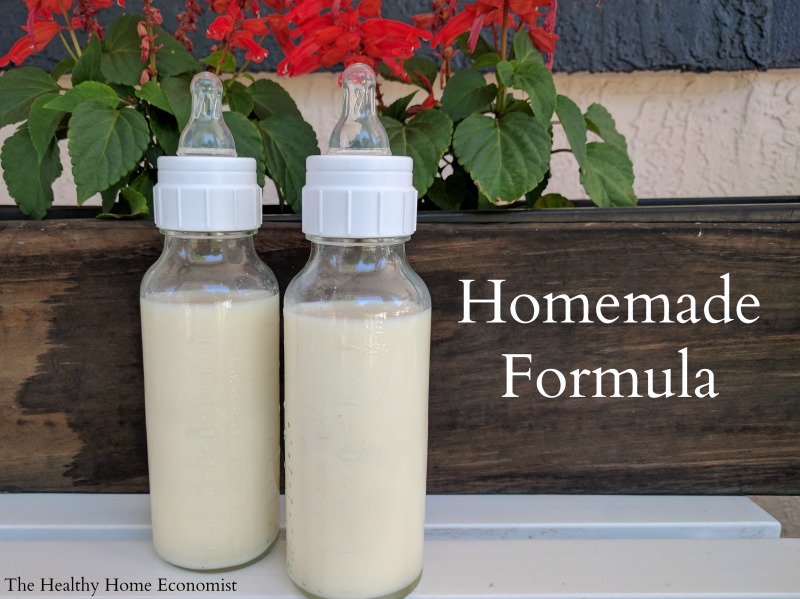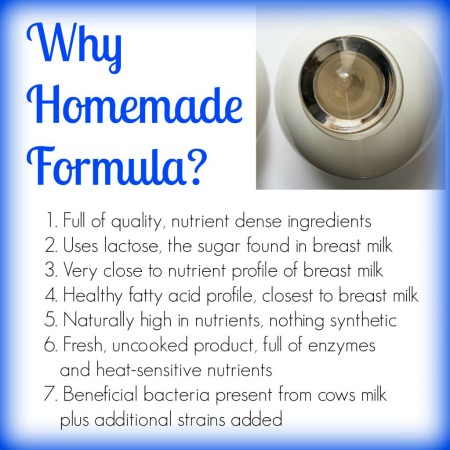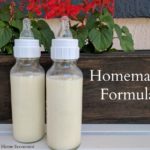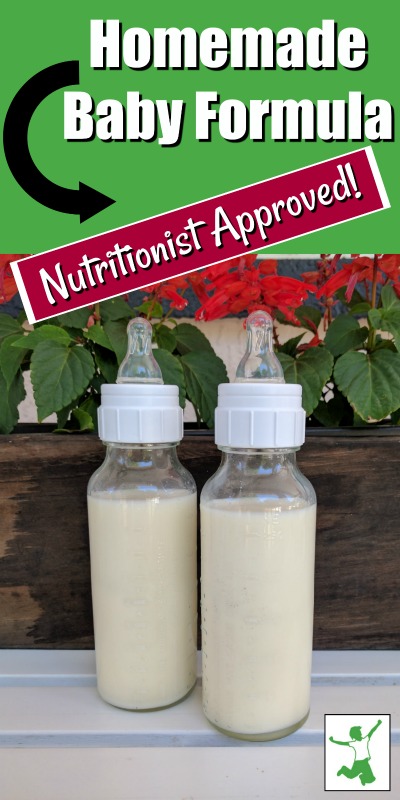Table of Contents[Hide][Show]
A nourishing homemade baby formula using safe, whole ingredients. This recipe was developed and tested by Dr. Mary Enig, a PhD Nutritionist and originally published in Nourishing Traditions cookbook in 1996. It was formulated to match breastmilk as closely as possible and is also suitable for infants. Source: Weston A. Price Foundation

There is no doubt that breastfeeding your baby is the best option for the child’s long-term health and development. Human breastmilk from a well-nourished mother is the perfect food for baby. However, in circumstances where the child is adopted or the Mother finds herself unable to breastfeed, formula feeding becomes necessary. In those cases, homemade baby formula is best.
Using a baby formula recipe that closely matches the nutritional profile of breastmilk is a far better choice than even organic baby formula from the health food store. More on this below.
Note: Donor programs are widely available for human breastmilk. But, the diets of the donor mothers are unknown and most likely nutritionally insufficient. In addition, breastmilk banks pasteurize the donated breastmilk which destroys much of the nutritional benefit. Unless you are fortunate to have a trusted and direct donor milk source in your community, avoid this option!
Dangers of Commercial Formula
Commercial formulas are always a poor choice for a number of reasons. First of all, formula manufacturers line the cans with the chemical BPA. This substance disrupts hormone development and is a probable contributor to early puberty in girls, and ADHD, urogenital abnormalities, and other ills in boys.
The European Food Safety Authority found that canned commercial formula is a significant source of BPA for infants, exposing the child to 13mcg of BPA per kg of body weight per day! BPA-free formula cans are no better. The chemical BPS is typically used instead which is just as dangerous.
Beware that manufacturers pack even organic commercial formula like Earth’s Best in BPA cans. Worse, they use organic brown rice syrup as the primary sweetener which is known to be frequently contaminated with arsenic.
In addition, all commercial milk formulas are processed at extremely high temperatures which violently denature the fragile milk proteins, render them allergenic, and add carcinogens to the final product. Soy infant formula is the worst. Obscenely high processing temperatures not only denature the proteins but large levels of phytic acid in soy block mineral absorption by the infant. Moreover, soy-based plant estrogens disrupt the hormonal development of the baby!
It seems that for the concerned Mother who is unable to breastfeed, learning how to make baby formula at home with safe, pure ingredients is the most prudent way to go!
Why Make Homemade Formula Even if You Are Breastfeeding
In the video below, I show you how to make your own safe, healthy raw milk homemade formula for your baby.
The recipe I follow was originally published in the cookbook Nourishing Traditions in 1996 and developed by Dr. Mary Enig.
Even though I breastfed each of my children for at least 2 years, I made this exact formula for my own children when I was away for the day or the evening as pumping was not an option that worked well for me.
I even used this homemade formula for an entire day once when I had some dental work done and was advised to pump and discard for 24 hours.
As a result, even successfully breastfeeding Moms can use this wonderful homemade formula as a supplement when necessary to their own nutrient-dense breastmilk!
It is advised that even breastfeeding Mothers have the ingredients for this formula on hand for an emergency. If Mom is sick or otherwise unable to nurse, Dad can step in and make this safe alternative until Mom is back on her feet. It takes a few days to a week to gather all the ingredients together to make this formula, which is why I advise having them on hand at all times.
Homemade Most Nutritious
The image below lists the reasons why it is worth it nutritionally to make formula yourself for your precious baby!
You can order all of the required ingredients for the homemade baby formula in one package from this reputable, vetted source.
Moms who have successfully used this formula feeding your children, please post about your experience in the comments section to encourage those who are considering it and need some Mom to Mom encouragement!

Where to Source Quality Milk
The most widely available grass-fed milk around the world is from cows. This is usually the most budget-friendly and easily sourced milk for this recipe for homemade formula.
If only goat milk is available in your area, this recipe for goat milk baby formula can be used instead. When using milk from ewes, please refer to the linked article for an adjusted recipe; one of the benefits of sheep milk is that it is higher in healthy fats than either goat or cow milk.
Camel milk formula is another option that is a particularly digestible form of dairy and growing in popularity around the world.
Alternatively, you can use low temp (vat) pasteurized, non-homogenized whole milk cultured with a piima or kefir starter. Then substitute the piima milk or kefir for the raw milk portion of the formula recipe. Cold-pressed raw milk also must be cultured before using it as it contains no probiotics.
Do NOT use ultrapasteurized (UHT) milk even if organic as it is too highly processed and extremely allergenic!
It is also best to avoid all types of powdered milk for this recipe. The factory process of making milk powder reduces nutrition considerably and denatures it, which makes it more likely baby will have an allergic reaction.
Dairy Allergy Option
If all types of dairy prove unsuitable for your baby, make this nondairy baby formula recipe instead. It uses a base of homemade bone broth as a substitute for milk. It is important not to utilize a plant-based or otherwise vegan baby formula recipe.
Avoid buying bone broth to make the dairy-free formula. Make it yourself! Manufacturers of commercial bone broth, even if authentic, may water down the end product. This is apparent if it does not gel when chilled in the refrigerator.
Many brands have toxic packaging issues as well. If you must buy it in a pinch, see my shopping guide page for vetted brands that are safe.

Homemade Baby Formula Recipe (for infants too)
A nourishing baby formula recipe you can make at home with safe, whole ingredients developed and tested by a PhD nutritionist to match breastmilk as closely as possible. Also suitable for infants.
Ingredients
- 2 cups raw cow milk OR organic whole milk yogurt
- 1 7/8 cups filtered water
- 1/4 cup liquid whey
- 4 Tbl lactose
- 1/4 tsp Bifidobacterium infantis powder
- 2-4 Tbl raw or pasteurized cream
- 1/2 tsp cod liver oil unflavored
- 1/4 tsp butter oil unflavored
- 1 tsp sunflower oil preferably organic
- 1 tsp extra virgin olive oil preferably organic
- 2 tsp virgin coconut oil preferably organic
- 2 tsp nutritional yeast
- 2 tsp gelatin
- 1/4 tsp acerola powder
Instructions
-
Fill a 2 cup Pyrex measuring cup with filtered water and remove 2 TBL (this will give you 1 7/8 cup water).
-
Pour about half the water into a pan and turn burner on medium.
-
Add the gelatin and lactose and let dissolve, stirring occasionally.
-
When gelatin and lactose are dissolved, remove pan from heat and add the rest of the water to cool.
-
Stir in the coconut oil and butter oil until melted.
-
Put remaining ingredients in a glass blender.
-
Add the water mixture and blend for about 3 seconds.
-
Place formula in glass baby bottles or a glass jar and refrigerate.
-
Before giving to baby, warm glass bottle in a pan of hot water or a bottle warmer. NEVER microwave baby bottles!
Recipe Video
Recipe Notes
If using raw cow milk from holstein cows, use 4 Tbl of extra cream (otherwise use 2 Tbl extra cream).
If choosing to make this homemade formula with camel milk, be sure to include 4 Tbl extra cream as camel milk is lower in cream than cow milk.
Do not use high oleic sunflower oil. Use only the brand recommended in the ingredients list which is cold pressed, organic, unrefined, and low oleic.
*Do NOT use powdered whey from the store as it is denatured. Avoid whey from making cheese as it will curdle the formula.
*Do not substitute pasteurized or powdered milk as these are heavily processed, denatured and allergenic foods.
*Do NOT use ultrapasteurized (UHT) cream. It is highly allergenic. Raw or pasteurized cream is acceptable.
*Do NOT use fish oil or krill oil instead of high vitamin cod liver oil as they do not contain any Vitamin D and very little to no Vitamin A.
Collagen powder may be substituted for the gelatin in a pinch (more on peptides in baby formula in this article).
If you are wondering where is the iron in homemade baby formula, this article provides an explanation.
If baby experiences constipation using this formula, try adding 1 tsp of molasses to each batch. This should help move things along.
How to Transition to DIY Formula
Once you’ve viewed the video, gathered the ingredients, and made your first batch, how do you feed it to your baby for the first time?
It is important not to switch all at once as this can cause gas, excessive spit-up, or an uncomfortable change in diaper habits such as constipation or overly loose stools.
Start by giving your baby three-quarters of the old formula blended with one-quarter of the homemade. Try this ratio for a day or two and see how your infant responds.
If no digestive upset or major change in diaper habits occurs, increase the amount to a 50-50 blend of old formula to homemade. Observe for another day or two as before.
If no major issues, increase once again to three-quarters homemade formula to one-quarter old formula. If baby does well on this blend for a third time, you are ready to fully transition to the homemade formula.
At any time during the transition, symptoms of intolerance emerge, back up to the previous successful blend ratio and stay there for a day or two before attempting to increase once again.
Homemade Formula FAQ
Weston Price Foundation
Feeding an Adopted Baby
Traveling Tips with Baby Formula Made at Home
Iron in Baby Formula
Collagen Peptides instead of Gelatin for Homemade Formula?










Is there a known calorie count for this? For example breast milk is approx 20 calories an ounce (some as much as 22 or as low as 18). I can’t wait to make this for my beautiful twins! My starter package arrived today! Many thanks Sarah!
I input the recipe into My Fitness Pal and it came back with 23.16 calories per ounce
Can anyone tell me once the formula is made how long it will last in the fridge??
I felt comfortable using mine up to 48 hours in the fridge, though 24 is probably a better goal. I also froze our formula in mason jars to be defrosted when needed.
how much does it cost to make this recipe ?
Holly,
I don’t remember the exact cost breakdown for us but it was significantly less per counce than the cheapest formula (Nature’s One Baby’s Only). To use powdered formula for our boys at one point would have cost $600 a month; we budgeted about $75 per month for formula ingredients in addition to our milk cost. And it’s much richer in nutrients and doesn’t have yucky ingredients.
I do have a spreadsheet with a cost breakdown of ingredients for the initial costs. You can email me at [email protected] and I’ll send it to you.
My daughter and I had trouble with breastfeeding, she was burning more calories then what she was getting. She lost almost 10% of birth weight. We ended up supplementing and switching over to Formula, she put weight on but burped and farted like it was no one’s business. My husband said we should make Home Made formula, I was hesitant but liked the idea that there’s no High Fructose corn syrup. ( I didnt like how your hands always got sticky with regular formula got on them) So at almost 2 months old we switched her from powdered formula to Home made formula. we use a Powdered Goats milk base, no access to raw milk in the woods in Kentucky. She’s flourished!! The spitting up stop and the burping and farting slowed down a lot too. I know what’s in her formula and what each ingredient is providing for her. I really wish people are more open and understanding of this process, as we don’t tell a lot of people as we are afraid of their reaction. Including the Pediatrician. I do plan on telling the pediatrician at her 1 year old check up. we also plan to keep her on this formula as we don’t believe it’s “wholesome” to switch her to solids and cows milk. Doesn’t seem like all her nutritional needs will be met. I’ll never go back or regret switching her. As a new mom ( and still figuring things out) I’ve figured out to listen to your gut, If it feels right then your doing it right.
Jessica,
Great work for using the homemade formula and listening to your “gut” on the issue of infant nutrition!! My son has been on the homemade formula since he was 6 weeks old. He is adopted, and at first he was on Enfamil and he was terrible with it- collicky and would not sleep at night, poor boy. . I had heard about the homemade formula, but I was reluctant at first. AT 6 weeks old, switched to the homemade formula and the change was remarkable. No more stomach issues, slept all through the night at 2 months old and has not been sick at all over the past year. He is now almost 14 months old and super smart and super solid muscled baby! I do not mention the homemade formula to the doctor because as long as I am hearing that he is doing really well and is at the top of his percentile, there is not reason for them to know! I am still feeding him formula first thing in the morning and before he goes to bed and the rest of the day he has cow’s milk and solids. I never give him any juice (too much sugar). He does get kefir drink though too.
I agree that more people need to know about this formula, however people do not understand the benefit and right away assume that because the commercial formula is “recommended” it is the best for babies. . Ugh…I read the ingredients and most things I could not even pronounce.
Long winded comment, but I am glad the formula worked out for you!!
I am starting to make broth/liver-based formula. I am worried about the inconsistency in broth making. Today, I used 1 whole chicken with 3 Tbsp ACV and 5 quarts water. I simmered, covered, for 12 hours. I ended up with just shy of 4.5 quarts of stock, which is now in the fridge so I can take the fat off the top. Did I do this right for the purpose of homemade formula? I m so worried about not making it right and not having enough nutrients, gelatin, etc. Please respond as soon as possible! Thank you!
Brooke
If your making stock all the nutrients come from the bone marrow. I wouldn’t use a whole bird, get backs and feet. They will give you a better end product.
I have been making the formula now for a week now. Ever since I switched my baby has been spitting up more, bad cradle cap, has gotten baby acne and is now pooping once a day. He was pooping 3 to 4 times a day. I was using the Holle Organic brand formula which was very pricy due to the fact that it is not made in the US. I was excited for the homemade formula but I am afraid he is reacting. Any modifications I can make?
Thank you
Jeni
maybe its a milk allergy? i was planning on making this with goats milk. i know its not recommended but its a back up only. i know raw milk is suppossed to be better cause it doesnt cause allergies. but obviously i am not medically trained lol. mayeb try making the meat based formula thats on the weston A. price foundation website. good luck!
Hi Jeni, did this acne or cradle cap get better over time? Did you continue using the homemade formula? I find my little girls are having more cheek looking acne and cradle cap after starting them on the goat milk formula. Not sure if this is just overlap in the age with them being 42 weeks and starting the homemade formula at the same time or because it is heavy in oils. Thanks
Any mums here that can help? have two questions
baby REACTS TO COD LIVER OIL ANY IDEA OF SUBSTITUTES?
BABY POOPING AFTER EVERY SINGLE BOTTLE IS THIS NORMAL?
tHANKS!
Please, can anyone tell me, once the formula is out of the fridge and heated, how long before it ‘spoils’? The formulas all say it has to be used within an hour of feeding because of the bacteria. Is this the same for this formula?
If the baby is drinking out if the bottle some if his saliva will go into the bottle. This is what they mean by bacteria, the bacteria from babys saliva. When my baby was quite young i followed that recommendation of tossing the leftover milk after about an hour. However if baby has not drank out of the bottle yet, you can keep the milk out of the fri d ge for quite a while. If i need the bottle to be out of fridge all day i put in an insulated bag with an ice pack. I have had a bottle in my purse at room temp for up to 8 hours before with no problem also.
can you leave the botttle with leftover raw milk up to an hour? even at room temperature? isnt that dangerous? cause once we use the milk, we warm it first by puttin the bottle in a pan with hot water, then the baby sometimes doesnt finish, and we put it back in fridge, which probably isnt smart im guessing with possible contamination, so we going to stop doing that.. so, again, can you leave it up to an hour at room temperature?
Yes that’s fine.